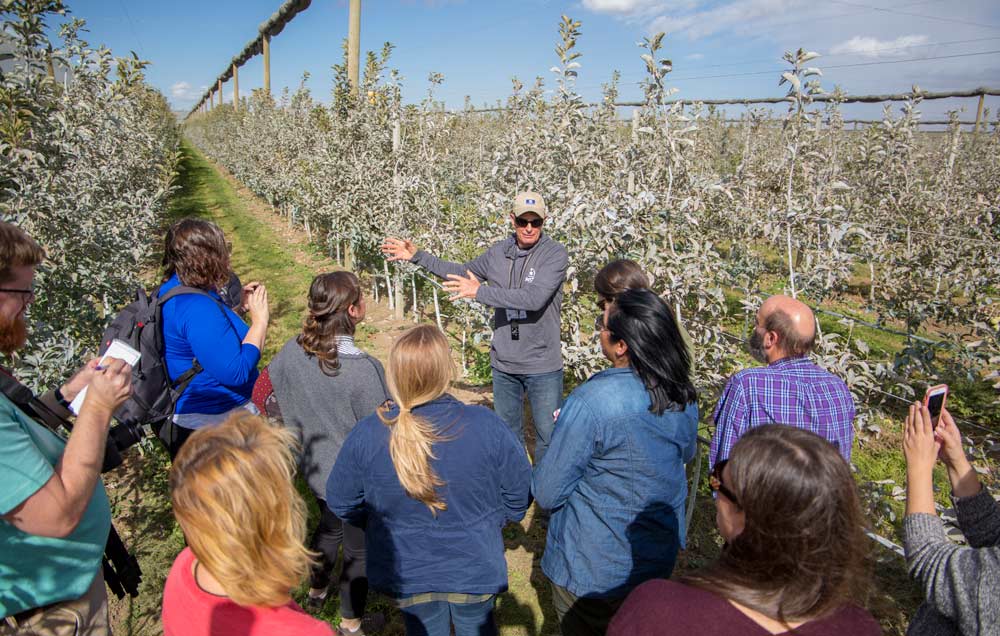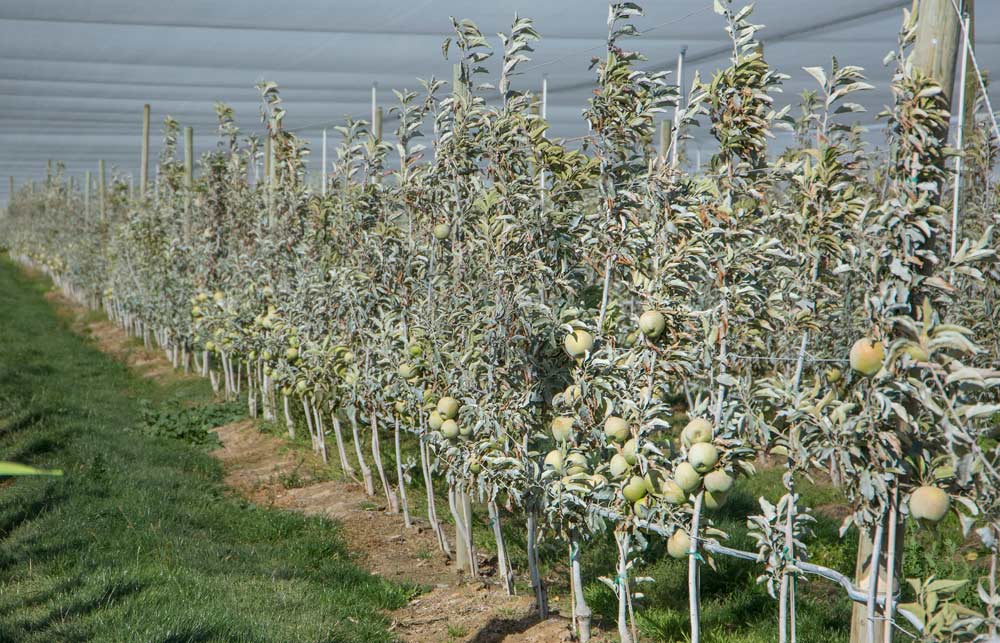
Neal Carter, founder and president of Okanagan Specialty Fruits, leads a tour of bloggers, trade journalists and dietitians in early October through his company’s Eastern Washington orchards. The company is rapidly ramping up production of its Arctic apples, genetically altered to not turn brown when sliced or bruised. (Ross Courtney/Good Fruit Grower)
The Canadian developers of the genetically altered Arctic apples are ramping up production and preparing to build their first packing and slicing facility.
And they’re not messing around.
“This is a very ambitious program,” said Neal Carter, founder and president of Okanagan Specialty Fruits, during a tour of his Eastern Washington orchards in October. The company uses RNA interference to silence the expression of the gene that causes sliced or bruised apples to turn brown.
The Summerland, British Columbia, company has about 600 acres of Golden Delicious, Granny Smiths and Fujis now and could reach just over 2,000 by 2020, Carter said. That’s enough for 2,000 bins this year and a projected 40,000 bins for 2020. The company has contracts with several Washington nurseries to produce the trees.
Meanwhile, Okanagan Specialty Fruits, or OSF, plans next year to start work on a packing and slicing facility in rural Central Washington. The company has, in the past, experienced vandalism by suspected protesters, so Good Fruit Grower is not sharing the name of the neighboring city.
The plant will start at 96,000 square feet, with an automated grading line and slicing equipment ready for the 2019 crop. Future phases call for expansion to roughly 1 million square feet by 2026, adding more slicing capacity, controlled-atmosphere storage and automated bin storage and product retrieval.
Also, OSF is growing its own apples, a departure from the original business plan to recruit growers with royalties, much like a club variety. In 2015, publicly traded synthetic biology corporation Intrexon acquired OSF as a wholly owned subsidiary and convinced Carter and his team to vertically integrate to control quality, consistency and the environmental and food safety messages.

Arctic Granny Smith apples ripen on trees under netting in Eastern Washington. The company, intending to slice its apples, harvests Grannies later than most growers and even lets them develop a little blush before picking. (Ross Courtney/Good Fruit Grower)
“They felt strongly that they wanted to keep control of it, being a genetically modified apple, the stewardship obligations and feelings of responsibility and stewardship were important,” he said.
Carter and his company, small at the time, gulped at the scale but feel up to the challenge now.
“That’s a long value chain that we’re trying to manage, and we feel strongly we’re going to be successful with it,” he said.
Today, OSF has roughly 25 employees, but that is expected to jump to 240 when the first phase of the facility comes online.
They chose Eastern Washington for production due to less expensive land prices, ample irrigation water and a labor force that is tight, but not as tight as Canada’s, Carter said. OSF plans to produce in Canada, perhaps in Ontario, and the Eastern U.S. at some point.
Meanwhile, Arctic apples are making their way through the regulatory process in Argentina, where the company will grow fruit to fill the market year-round; plants are in quarantine there now. Also, the company seeks food approval in Mexico as an export market for whole and sliced apples.
Horticulture
Okanagan Specialty Fruits takes a different — if not completely opposite — horticultural approach to fruit production than do traditional orchardists. Company leaders suspect the fresh sliced market will be their retail sweet spot, so they are growing fruit specifically for slicing as opposed to fresh-packed whole apples.
For one thing, they want to keep their apples small, said Eddy Mejia, orchard manager. “When you’re in the fresh market you try to hit for the bigger size,” Mejia said. “We try to keep our sizes down so it’s easier for the company to slice all the apples.”
Thus, they likely will crop heavier to increase tonnage, then prune and thin by the numbers. They aim for between 95 and 110 bins per acre at their various Granny Smith and Golden Delicious orchards.
They also are less interested in color than fresh pack growers, aiming to harvest at peak ripeness rather than plan for storage. They even let their Granny Smiths develop some blush, something whole apple shippers would not want.

Neal Carter answers questions on a tour through his Arctic apple orchards in October 2018. Foods changed by manipulation at the genetic level, regardless of degree or technique, carry the aura of controversy, something Carter and company officials have become well-practiced at countering. (Ross Courtney/Good Fruit Grower)
Otherwise, the company’s orchards look like any other modern orchard. They use a mixture of single-spindle trellised or V-trellised trees, trellises at a height of 8 feet or 10 feet, 10-foot row spacing and between 2- and 3-foot tree spacing. Each block has both drip irrigation and overhead sprinklers for evaporative cooling.
The company is using ladders now but eventually aims to incorporate harvest platforms, Mejia said.
Controversy
Okanagan Specialty Fruits is growing its own fruit now but has not ruled out a day when the company may want to contract growers, as originally planned. Some in the industry suspect that will take convincing.
Foods changed by manipulation at the genetic level, regardless of degree or technique, carry the aura of controversy, something Carter and company officials have become well-practiced at countering. Carter was a guest on the Dr. Oz show in 2015 and has been interviewed by the New York Times, Wired magazine and Scientific American. Some industry officials publicly expressed skepticism and even spoke against deregulating Arctic apples.
Today, Grannies and Goldens are fully approved by agricultural and food regulatory agencies in Canada and the U.S., while Fujis still await approval from the Food and Drug Administration. Thus, the company may grow the apples but not yet sell them.
Sliced Arctic Goldens made it onto Midwest store shelves last year. With the 2018 crop, OSF will add Granny slices and whole apples to the menu and penetrate more geographic areas. Meanwhile, OSF’s Arctic ApBitz dried fruit snacks are for sale online through Amazon.
So far, the company is focusing on U.S. markets but will add availability in Canada in 2019, once it has enough volume, said Denise Everett, a company spokeswoman.
Now that the Arctic apple is for sale, Carter figures potential growers would eye more practical concerns, such as packouts and returns.
Tour
Still, to help plead their case to the public, Carter and his Okanagan Specialty Fruits colleagues led a tour through their Eastern Washington properties in early October for 10 dietitians, trade journalists and food bloggers from around the nation, bunking down for two nights in glamping yurts at a wine resort.
With Carter — who still owns a small cherry and apple orchard in Summerland with his wife, Louisa — leading the way through his Arctic rows, the group discussed public perception, but also more mundane modern orchard techniques such as overhead netting, wind machines, drip irrigation and digital pest control modeling.
Some of the tour participants were established pro-science personalities. A few have even marched in counterprotests opposite food safety and organic advocates.

DNA extracted from frozen strawberries droops from a wooden stick as tour-goers wrap up a science lesson before learning more about RNA interference and visiting the Arctic orchards. (Ross Courtney/Good Fruit Grower)
Kavin Senapathy is an author and organizer of pro-science food movements and is part of a team of writers dubbed the Science Moms who aim to counterpunch what they regard as unnecessary fear about changes in food production. She had heard a lot about the Arctic apples and wanted to see if they were as good as the nonbrowning, less-waste hype. She also wanted to share with her readers how they are grown and details of the people behind the apple.
Senapathy likens nonbrowning apples to seedless watermelons. She remembers as a child listening to her parents and other adults rail against them, but today they are more common than seeded melons. She figures consumers eventually will get used to genetically changed apples the same way.
“I would hope to see most apples in the store be Arctic apples,” she said. “I don’t know if that’s going too far.” •
—by Ross Courtney






Leave A Comment